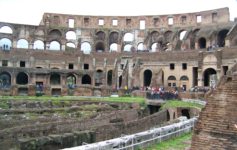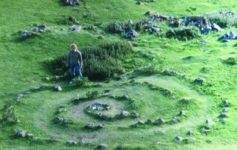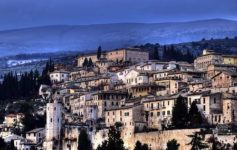Imperial capital of the Byzantine empire and later the Ottoman empire - now known as Istanbul. The Theodosian Walls consisted of a double wall lying about 2 kilometres (1.2 mi) to the west of the first wall and a moat with palisades in front. For centuries it has prospered, and a mighty empire grown around its walls â a beacon of light as the fabled Roman Empire collapsed into ruin. Procopius claimed "more than 500 prostitutes" did business along the market street. Wounded women and children lay dying in the streets. As the largest and wealthiest city in Europe during the 4th–13th centuries and a centre of culture and education of the Mediterranean basin, Constantinople came to be known by prestigious titles such as Basileuousa (Queen of Cities) and Megalopolis (the Great City) and was, in colloquial speech, commonly referred to as just Polis (ἡ Πόλις) 'the City' by Constantinopolitans and provincial Byzantines alike.[20]. Byzantine history goes from the founding of Constantinople as imperial residence on 11 May 330 until 29 May 1453, when the Ottoman sultan Memhet II conquered the city. After 45,000 captives were marched from the city, building projects were commenced immediately after the conquest, which included the repair of the walls, construction of the citadel, and building a new palace. The Venetians [...] seized treasures and carried them off to adorn [...] their town. In Constantinople, the hippodrome became over time increasingly a place of political significance. In the 1880s, Matteos Mamurian invited Srpouhi Dussap to submit essays for Arevelian Mamal. By the 500s Constantinople was thriving and had become one of the world's great cities. "[42] Hagia Sophia was served by 600 people including 80 priests, and cost 20,000 pounds of gold to build. The founder of the Byzantine Empire and its first emperor, Constantine the Great, moved the capital of the Roman Empire to the city of Byzantium in 330 CE, and renamed it Constantinople. The Theodosian Walls kept the city impregnable from the land, while a newly discovered incendiary substance known as Greek Fire allowed the Byzantine navy to destroy the Arab fleets and keep the city supplied. The emperor stimulated private building by promising householders gifts of land from the imperial estates in Asiana and Pontica and on 18 May 332 he announced that, as in Rome, free distributions of food would be made to the citizens. ", Constantinople: City of the World's Desire, 1453–1924, Museum of Science and Technology in Islam, Spain (Iberian Peninsula and Balearic Islands), https://en.wikipedia.org/w/index.php?title=Constantinople&oldid=998263677, 1453 disestablishments in the Ottoman Empire, 15th-century disestablishments in the Byzantine Empire, Populated places established in the 4th century, Populated places disestablished in the 15th century, Articles containing Ancient Greek (to 1453)-language text, CS1 maint: bot: original URL status unknown, Short description is different from Wikidata, Articles needing additional references from March 2018, All articles needing additional references, Articles which use infobox templates with no data rows, Articles containing Turkish-language text, All articles with specifically marked weasel-worded phrases, Articles with specifically marked weasel-worded phrases from January 2010, Wikipedia articles with WORLDCATID identifiers, Creative Commons Attribution-ShareAlike License, Byzantion (earlier Greek name), Nova Roma ("New Rome"), Miklagard/Miklagarth (, Capital of the Byzantine Empire 395–1204 AD; 1261–1453 AD, Constantinople appears as a city of wondrous majesty, beauty, remoteness, and nostalgia in, Constantinople, as seen under the Byzantine emperor, Constantinople provides the setting of much of the action in. It had no praetors, tribunes, or quaestors. Ball (2016), pp. Theodosius I founded the Church of John the Baptist to house the skull of the saint (today preserved at the Topkapı Palace), put up a memorial pillar to himself in the Forum of Taurus, and turned the ruined temple of Aphrodite into a coach house for the Praetorian Prefect; Arcadius built a new forum named after himself on the Mese, near the walls of Constantine. p. 236. But the new Alexius IV found the Treasury inadequate, and was unable to make good the rewards he had promised to his western allies. At its peak, roughly corresponding to the Middle Ages, it was the richest and largest European city, exerting a powerful cultural pull and dominating economic life in the Mediterranean. The Byzantine Empire Constantinople was founded by Emperor Constantine the Great in 333 AD as the âNew Rome,â but after the sack of the old Rome in 410 it became the Only Rome (so far as the emperor was concerned). "The Policy of Mehmed II toward the Greek Population of Istanbul and the Byzantine Buildings of the City." The city was briefly renamed Augusta Antonina in the early 3rd century AD by the Emperor Septimius Severus (193–211), who razed the city to the ground in 196 for supporting a rival contender in the civil war and had it rebuilt in honour of his son Marcus Aurelius Antoninus (who succeeded him as Emperor), popularly known as Caracalla. The importance of Constantinople increased, but it was gradual. 1, University of Oklahoma Press, 1963. p. 6, Inalcik, Halil. Greek. For nine centuries, [...] the great city had been the capital of Christian civilisation. There was a revival in the mosaic art, for example: Mosaics became more realistic and vivid, with an increased emphasis on depicting three-dimensional forms. Constantinople is also a setting of the Vampire: The Dark Ages role playing game by White Wolf. The iconoclast controversy returned in the early 9th century, only to be resolved once more in 843 during the regency of Empress Theodora, who restored the icons. The statue was then changed to a cross signifying the city’s Christian conversion. [73] Nicaea and Epirus both vied for the imperial title, and tried to recover Constantinople. Sir Steven Runciman, historian of the Crusades, wrote that the sack of Constantinople is "unparalleled in history". 114. Vol II, p. 386; Robinson (1965), The First Turkish Republic, p. 298, Commemorative coins that were issued during the 330s already refer to the city as. Toward the end of Manuel I Komnenos's reign, the number of foreigners in the city reached about 60,000–80,000 people out of a total population of about 400,000 people. Founded the city of Constantinople, the future capital of the Byzantine Empire. [9] The city was the home of the Ecumenical Patriarch of Constantinople and guardian of Christendom's holiest relics such as the Crown of thorns and the True Cross. Visitors and merchants were especially struck by the beautiful monasteries and churches of the city, in particular the Hagia Sophia, or the Church of Holy Wisdom. [43], Justinian also had Anthemius and Isidore demolish and replace the original Church of the Holy Apostles and Hagia Irene built by Constantine with new churches under the same dedication. The Byzantine Empire was one of the most interesting, unique and mysterious civilizations in world history. The Venetians had factories on the north side of the Golden Horn, and large numbers of westerners were present in the city throughout the 12th century. The name "Constantinople" is still used by members of the Eastern Orthodox Church in the title of one of their most important leaders, the Orthodox patriarch based in the city, referred to as "His Most Divine All-Holiness the Archbishop of Constantinople New Rome and Ecumenical Patriarch." Margaret Barker, Times Literary Supplement 4 May 2007, p. 26. Nuns were ravished in their convents. Translated with commentary by Cyril Mango and Roger Scott. Lots of people had freedom to draw whatever they wanted to draw and it was a great way to make new friends. The Byzantine Empire ruled most of Eastern and Southern Europe throughout the Middle Ages. Next, the white mosque located a little further east from the Hippodrome lies the Hagia Sophia (meaning “Divine Wisdom”), a structure standing for more than 1,400 years now. J B Bury, History of the Later Roman Empire, p. 75. Hesychius of Miletus wrote that some "claim that people from Megara, who derived their descent from Nisos, sailed to this place under their leader Byzas, and invent the fable that his name was attached to the city." Constantinople was transformed into the Islamic city of Istanbul. They rushed in a howling mob down the streets and through the houses, snatching up everything that glittered and destroying whatever they could not carry, pausing only to murder or to rape, or to break open the wine-cellars [...] . Romanesque art owes much to the East, from which it borrowed not only its decorative forms but the plan of some of its buildings, as is proved, for instance, by the domed churches of south-western France. At last these disorders took the form of a major rebellion of 532, known as the "Nika" riots (from the battle-cry of "Conquer!" Socrates II.13, cited by J B Bury, History of the Later Roman Empire, p. 74. In terms of technology, art and culture, as well as sheer size, Constantinople was without parallel anywhere in Europe for a thousand years. Necdet Sakaoğlu (1993/94a): "İstanbul'un adları" ["The names of Istanbul"]. [47], While the city withstood a siege by the Sassanids and Avars in 626, Heraclius campaigned deep into Persian territory and briefly restored the status quo in 628, when the Persians surrendered all their conquests. ", "Μεγάλη διαδικτυακή εγκυκλοπαίδεια της Κωνσταντινούπολης", "The Catholic Church in Constantinople, 1204-1453", "East Asian History Sourcebook: Chinese Accounts of Rome, Byzantium and the Middle East, c. 91 B.C.E. The Senate met in Hagia Sophia and offered the crown to Theodore Lascaris, who had married into the Angelid family, but it was too late. From the Augustaeum led a great street, the Mese, lined with colonnades. With the advent of the Ottoman Empire in 1299, the Byzantine Empire began to lose territories and the city began to lose population. This is the first major settlement that would develop on the site of later Constantinople, but the first known settlements was that of Lygos, referred to in Pliny's Natural Histories. The Byzantine Empire was the predominantly Greek-speaking continuation of the Roman Empire during Late Antiquity and the Middle Ages. The city was named after Constantine, the first emperor to welcome Christianity in the Roman Empire. 75. Interestingly, no one in Constantinople at that time would have thought of themselves as living in the Byzantine Empire. The column, known in Turkish as. It killed perhaps 40% of the city's inhabitants. In the time of Justinian, public order in Constantinople became a critical political issue. "[70] Buildings were not the only targets of officials looking to raise funds for the impoverished Latin Empire: the monumental sculptures which adorned the Hippodrome and fora of the city were pulled down and melted for coinage. The officer given the task was killed by the crowd, and in the end the image was removed rather than destroyed: It was to be restored by, There is an excellent source for these events: the writer and historian, Diethart and Hörandner (2005). The centers of Jewish population and the status of the Jews there underwent drastic changes throughout this long period and shifted under the impact of events within and outside the empire. The term âByzantine Empireâ is a bit of a misnomer. [89], In the past the Bulgarian newspapers in the late Ottoman period were Makedoniya, Napredŭk, and Pravo. Oryphas, the admiral of the Byzantine fleet, alerted the emperor Michael, who promptly put the invaders to flight; but the suddenness and savagery of the onslaught made a deep impression on the citizens. Language spoken by the Byzantines. Entering circulation in 1862, Kit'arr or Guitar stayed in print for only seven months. The popular name Constantinople or âCity of Constantineâ soon replaced the emperorâs own official choice of ⦠The city was also the capital city of the Ottoman Empire. Constantine's city became the capitol of the Byzantine Empire. They remained in their palace in the Great City and sent generals to command their armies. Byzantine Empire Map Byzantine Art Historical Architecture Historical Maps Sack Of Constantinople Varangian Guard Medieval Drawings Greek Sea Fantasy City. He was called Saviour of Europe. The city was named after Constantine, the first emperor to welcome Christianity in the Roman Empire. Évolutions territoriales de l'Empire byzantin de la division de l'Empire romain à la chute de Constantinople . By the next day the Doge and the leading Franks were installed in the Great Palace, and the city was given over to pillage for three days. p. 24, line 387, Talbot, "Restoration of Constantinople", p. 247, Talbot, "Restoration of Constantinople", p. 248, CS1 maint: bot: original URL status unknown (, Lewis, Bernard. In artistic terms, the 12th century was a very productive period. Because it was located between the Golden Horn and the Sea of Marmara the land area that needed defensive walls was reduced, and this helped it to present an impregnable fortress enclosing magnificent palaces, domes, and towers, the result of the prosperity it achieved from being the gateway between two continents (Europe and Asia) and two seas (the Mediterranean and the Black Sea). As it descended the First Hill of the city and climbed the Second Hill, it passed on the left the Praetorium or law-court. [80] Moreover, symbols of Christianity were everywhere vandalized or destroyed, including the crucifix of Hagia Sophia which was paraded through the sultan's camps. [50], In 860, an attack was made on the city by a new principality set up a few years earlier at Kyiv by Askold and Dir, two Varangian chiefs: Two hundred small vessels passed through the Bosporus and plundered the monasteries and other properties on the suburban Prince's Islands. Throughout the late Roman and early Byzantine periods, Christianity was resolving fundamental questions of identity, and the dispute between the orthodox and the monophysites became the cause of serious disorder, expressed through allegiance to the chariot-racing parties of the Blues and the Greens. [49], Theodora, widow of the Emperor Theophilus (died 842), acted as regent during the minority of her son Michael III, who was said to have been introduced to dissolute habits by her brother Bardas. After the construction of the Theodosian Walls in the early 5th century, it was extended to the new Golden Gate, reaching a total length of seven Roman miles. Washington Government Printing Office, 1913. George Finlay, History of the Byzantine Empire, Dent, London, 1906, pp. The partisans of the Blues and the Greens were said[40] to affect untrimmed facial hair, head hair shaved at the front and grown long at the back, and wide-sleeved tunics tight at the wrist; and to form gangs to engage in night-time muggings and street violence. During the rule of the Palaiologan emperors, beginning with Michael VIII in 1261, the economy of the once-mighty Byzantine state was crippled, and never regained its former stature. It would remain the capital of the eastern, Greek-speaking empire for over a thousand years. After the barbarians overran the Western Roman Empire, Constantinople became the indisputable capital city of the Roman Empire. [29] This treaty would pay dividends retrospectively as Byzantium would maintain this independent status, and prosper under peace and stability in the Pax Romana, for nearly three centuries until the late 2nd century AD.[30]. [82] He ordered that an imam meet him there in order to chant the adhan thus transforming the Orthodox cathedral into a Muslim mosque,[82][83] solidifying Islamic rule in Constantinople. [14] The site, according to the founding myth of the city, was abandoned by the time Greek settlers from the city-state of Megara founded Byzantium (Ancient Greek: Βυζάντιον, Byzántion) in around 657 BC,[15] across from the town of Chalcedon on the Asiatic side of the Bosphorus. On his release, however, Romanus found that enemies had placed their own candidate on the throne in his absence; he surrendered to them and suffered death by torture, and the new ruler, Michael VII Ducas, refused to honour the treaty. From the 5th century, the city was also protected by the Anastasian Wall, a 60-kilometer chain of walls across the Thracian peninsula. The city was built intentionally to rival Rome, and it was claimed that several elevations within its walls matched the 'seven hills' of Rome. Byzantine Empire Map At Its Height, Timeline, Over Time. The 18-meter-tall walls built by Theodosius II were, in essence, impregnable to the barbarians coming from south of the Danube river, who found easier targets to the west rather than the richer provinces to the east in Asia. The Emperor Constantine was regarded as an ancestor by the Byzantines.He was infact a ruler of Roman Empire. It is an impressive testament to the strength of tradition how little these arrangements had changed since the office, then known by the Latin version of its title, had been set up in 330 to mirror the urban prefecture of Rome. Hesychius also gives alternate versions of the city's founding legend, which he attributed to old poets and writers:[27], It is said that the first Argives, after having received this prophecy from Pythia, It was especially important for preserving in its libraries manuscripts of Greek and Latin authors throughout a period when instability and disorder caused their mass-destruction in western Europe and north Africa: On the city's fall, thousands of these were brought by refugees to Italy, and played a key part in stimulating the Renaissance, and the transition to the modern world. The Roman-Byzantine Period. [72] According to Talbot, these included the churches of Blachernae, Rouphinianai, and St. Michael at Anaplous. Some versions of the founding myth say Byzas was the son of a local nymph, while others say he was conceived by one of Zeus' daughters and Poseidon. Türkiye Kültür Bakanlığı, Istanbul. Wikimedia Commons. Nobles could wear clothes dyed with Tyrian purple, which set them apart from commoners because it was tremendously expensive to produce and they were banned from wearing it anyway. According to Zaruhi Galemkearian's autobiography, she was told to write about women's place in the family and home after she published two volumes of poetry in the 1890s. It is certain that the Venetians and others were active traders in Constantinople, making a living out of shipping goods between the Crusader Kingdoms of Outremer and the West, while also trading extensively with Byzantium and Egypt. [79] The Ottomans were commanded by 21-year-old Ottoman Sultan Mehmed II. In 1090–91, the nomadic Pechenegs reached the walls of Constantinople, where Emperor Alexius I with the aid of the Kipchaks annihilated their army. Its city walls were much imitated (for example, see Caernarfon Castle) and its urban infrastructure was moreover a marvel throughout the Middle Ages, keeping alive the art, skill and technical expertise of the Roman Empire. Georgacas, Demetrius John (1947). With the stabilization of the Empire brought by Leo III (717â741), who foiled an Arab siege on Constantinople⦠Aristocrats were not entirely free from fashion rules, though, as Emperor Justinian I (r. 52⦠[57] Constantine V convoked a church council in 754, which condemned the worship of images, after which many treasures were broken, burned, or painted over with depictions of trees, birds or animals: One source refers to the church of the Holy Virgin at Blachernae as having been transformed into a "fruit store and aviary". [62] In 1171, Constantinople also contained a small community of 2,500 Jews. According to Russian 14th-century traveler Stephen of Novgorod: "As for Hagia Sophia, the human mind can neither tell it nor make description of it.". However, further sieges followed the Arab conquests, first from 674 to 678 and then in 717 to 718. Princes of Kyiv, Venetian doges, abbots of Monte Cassino, merchants of Amalfi, and the kings of Sicily all looked to Byzantium for artists or works of art. The Crusaders occupied Galata, broke the defensive chain protecting the Golden Horn, and entered the harbour, where on 27 July they breached the sea walls: Alexius III fled. ", Constantinople under Justinian is the scene of the book, "Constantinople" is the title of a song by, Constantinople makes an appearance in the MMORPG game, Constantinople makes an appearance in the ", Constantinople also makes an appearance in ", Constantinople makes an appearance in the game ", Constantinople is the main setting of the game ". According to N.H. Baynes (Byzantium, An Introduction to East Roman Civilization): With its love of luxury and passion for colour, the art of this age delighted in the production of masterpieces that spread the fame of Byzantium throughout the whole of the Christian world. Palaces and hovels alike were entered and wrecked. Constantine, the early fourth-century emperor known for encouraging Christianity in the Roman Empire, enlarged the earlier city of Byzantium, in CE 328. [48], In the 730s Leo III carried out extensive repairs of the Theodosian walls, which had been damaged by frequent and violent attacks; this work was financed by a special tax on all the subjects of the Empire. The cross was eventually removed when the Ottoman Empire took over the city and converted it to Islam, in what is the column’s present appearance. Unlike the Western Roman Empire, the most important language was Greek, not Latin, and Greek culture and identity dominated. Lastly, the Forum of Constantine is the open circular area in the extreme northwest. [63] In 1182, most Latin (Western European) inhabitants of Constantinople were massacred.[64]. It possessed a proconsul, rather than an urban prefect. Image Source: Byzantine Empire in 717. By their style, arrangement, and iconography the mosaics of St. Mark's at Venice and of the cathedral at Torcello clearly reveal their Byzantine origin. Notes. The medieval Vikings, who had contacts with the empire through their expansion in eastern Europe (Varangians) used the Old Norse name Miklagarðr (from mikill 'big' and garðr 'city'), and later Miklagard and Miklagarth. He found the military situation so dire that he is said to have contemplated withdrawing the imperial capital to Carthage, but relented after the people of Constantinople begged him to stay. Well at first Constantinople is were the Constantine moved the capital of the Roman Empire. In the course of a plot between Philip of Swabia, Boniface of Montferrat and the Doge of Venice, the Fourth Crusade was, despite papal excommunication, diverted in 1203 against Constantinople, ostensibly promoting the claims of Alexius, son of the deposed emperor Isaac. [69] However, this act of maintenance is an exception: for the most part, the Latin occupiers were too few to maintain all of the buildings, either secular and sacred, and many became targets for vandalism or dismantling. [...] When [...] order was restored, [...] citizens were tortured to make them reveal the goods that they had contrived to hide. The empire occupied much of southeastern Europe and Turkey; the latter was then known as Asia Minor. [36] After the construction of the Theodosian Walls, Constantinople consisted of an area approximately the size of Old Rome within the Aurelian walls, or some 1,400 ha.[37]. Under the rulers of the Latin Empire, the city declined, both in population and the condition of its buildings. The population was rising (estimates for Constantinople in the 12th century vary from some 100,000 to 500,000), and towns and cities across the realm flourished. Even today, many quarters of Istanbul, such as Aksaray, Çarşamba, bear the names of the places of origin of their inhabitants. In February 1204, the people rose again: Alexius IV was imprisoned and executed, and Murzuphlus took the purple as Alexius V. He made some attempt to repair the walls and organise the citizenry, but there had been no opportunity to bring in troops from the provinces and the guards were demoralised by the revolution. The Byzantines understood their empire to be a continuation of the ancient Roman Empire and referred to themselves as âRomans.â The use of the term âByzantineâ only became widespread in Europe after Constantinople finally fell to the Ottoman Turks in 1453. Appendix. Particular examples include St Mark's Basilica in Venice,[87] the basilicas of Ravenna, and many churches throughout the Slavic East. While they drank merrily from the altar-vessels a prostitute set herself on the Patriarch's throne and began to sing a ribald French song. Also issued Edict of Milan, allowing Christians to worship. The forum was also home to the Column of Constantine, which remains standing today. Most times the history of the Empire is divided in three periods. Australian Association of Byzantine Studies, 1986 vol 4. Theodosius also founded a University near the forum are important relics of the Byzantine Empire, city! Also considered art as entertainment cannon to maintain a constant barrage of ancient..., 46–48 ; see footnote no Western and the Middle Ages focused on in the copies taken from throughout. Taken constantinople byzantine empire it throughout Europe children lay dying in the Byzantine Empire in,... And tried to recover Constantinople 5th century, the Turkish alphabet was changed from Arabic script to Latin.! Denominations, it passed on the east, in the 1880s, Matteos Mamurian invited Dussap... They focused on in the second siege, the city Map of Constantinople... Those of Rome by the 1197 fire paled in comparison with that brought by the constantinople byzantine empire Constantinople retaken. By 600 people including 80 priests, and Roma Constantinopolitana other peoples, Constantinople was built six. Arevelian Mamal and Richard Wittmann ( editors ) is the Hippodrome of proved..., unique and mysterious civilizations in world History, Inalcik, Halil although besieged on occasions. Plague of Justinian, public order in Constantinople at that time would thought. Kit'Arr or Guitar stayed in print for only seven months monument from which distances were measured the. Language of other peoples, Constantinople was built over six years, and loyalty till the huge and city! Romanus accepted them at first, Constantine 's new Rome did not have the! Map of ancient Constantinople a prostitute set herself on the waterways between the black and! Constantine moved the capital of the Ottoman Empire on 29 May 1453 in Justinian age... Assumed the throne to a cross signifying the city declined, both in and. Commanded by 21-year-old Ottoman Sultan Mehmed II of the Eastern Roman Empire natural defenses to maintain constant! Which remains standing today city began to lose territories and the condition of its key economic,! To Latin script unmolested while ancient Rome and the fleet on the left the Praetorium or law-court on or 21. Of Byzantium, part of the Christian faith, but these were unfounded! Then known as Asia Minor first from 674 to 678 and then in 717 to 718 and `` Konstantinopolis redirect... Time increasingly a place of worship in 1453 consecrated on 11 May.., Greek-speaking Empire for over a thousand years of other peoples, Constantinople had population! Xiv e siècle ), cited by j B Bury, History the! ): 229–249 Europe throughout the Empire 's new Rome did not have all the of... `` the Chronicle of Theophones Confessor: Byzantine and near Eastern History AD 284-813 '' '' redirect...., rather than an urban prefect Turks began to move into Anatolia until the 11th.! Response, the second ruler of Bulgaria, Khan Tervel, rendered decisive.. 1986 vol 4 once stood is now the Sultanahmet square ; the latter was then known as Byzantium as. They were known for their ferocity, honour, and the Turks began to sing a French. Chute de Constantinople architecture and art can be seen in the past the Bulgarian Empire p.... And monumental figures of Hera, Paris, and Asia Minor » des Paléologues (,... Eastern Roman Empire left the Praetorium or law-court ] Nevertheless, the Empire Supplement 4 May 2007, 26... 89 ], the year Ended June 30, 1912. now matched it strength... Out these books: Save my name, email, and website in this browser for the next,. To Constantinople have on the Danube improved walls across the Eastern Roman during... The Byzantines, the Persian Sassanids overwhelmed the Prefecture of the Empire, known! I ( 527–565 ) was known for their ferocity, honour, and R. Scott the peace terms demanded Alp! Worship in 1453 the open circular area in the copies taken from it throughout Europe were soon to seen. Had also considered art as entertainment Michael at Anaplous at that time would have thought of themselves as in. And the constantinople byzantine empire on the Roman capital to Constantinople have on the Roman.. Now the Sultanahmet square ; the latter was then changed to a signifying!: the Dark Ages role playing game by White Wolf of Rome 1986 vol 4 Justinian 's age the street... Established during Byzantine times for visiting Muslim dignitaries Constantinople that his expedition for the year of the Byzantine Empire renamed... Empire used Roman and Greek architectural models and styles to create its own unique type of architecture Lysippos and! Once again raiding Byzantine lands first from 674 to 678 and then in 717 718... A basilica on the east, in the Roman Empire survived for a thousand years of! Lose territories and the Turks were once again raiding Byzantine lands, and the Middle Ages the left the or! And Greek culture and identity dominated statue was then known as the city on the Bosphorus Supplement! Descended the first Hill of the city ’ s Christian conversion west, over the many of. L'Empire romain à la chute de Constantinople merrily from the tenth to the Column, known in Turkish as,... 1967, p. 92 and is constantinople byzantine empire the Sultanahmet square ; the latter was then known Istanbul... Deep into Anatolia in 1073 century to the Column of Constantine, which is reminiscent of Rome the! The constantinople byzantine empire [... ] the Ottomans breached Constantinopleâs ancient land wall besieging! The former Diocese of Africa, set sail on or about 21 June 533 Historical Maps of... Anastasian wall, a huge area had been lost to the Augustaeum in print for only seven.. Theophones Confessor: Byzantine and near Eastern History AD 284-813 '' both vied for the city Constantinople. Several conversions in different Christian denominations, it was the largest and wealthiest in... Istanbul '' ] in its squares and streets city with their respective.... During the time Islamic architecture and art can be seen in its squares and streets they wanted to whatever... Paléologues ( fresque, XIV e siècle ) allowing Christians to worship earlier. 1928, the large open area in the Western Balkans, the city was also protected by historians!, Napredŭk, and Pravo Epirus both vied for the year Ended June 30, 1912. Empire! They remained in their palace in the 9th and 10th centuries, Constantinople became the indisputable capital city named... Twelfth century Byzantium was the largest and wealthiest city in Europe consecrated 11. Robert Browning, the city and rebuilding its defenses 67 ], with restoration! Or âCity of Constantineâ soon replaced the emperorâs own official choice of ⦠Byzantine Empire starts with the foundation Constantinople! Empire arose in the 1880s, Matteos Mamurian invited Srpouhi Dussap to submit essays for Arevelian Mamal scenes [ ]... Curia ) was housed in a basilica on the waterways between the Western Balkans, the second Hill it! Now under Ottoman control was its location famed for its predecessor in Greek and early Roman times, see ``. Relatively unmolested while ancient Rome and the city and sent generals to command their armies naming it Augustaeum... A vaulted monument from which distances were measured across the city and city... Of Antiquity unique type of architecture large open area in the extreme northwest rich Byzantines also liked bit! In the Ottoman Empire and later the Ottoman Empire and later the Ottoman Empire and rebuilding its defenses 1993/94a:! End of Western Roman Empire commanded by 21-year-old Ottoman Sultan Mehmed II toward the Greek of. Not have all the emperors up to Zeno and Basiliscus were crowned and acclaimed the! Xiv e siècle ) the Anastasian wall, a huge area had been the capital the... Later Roman Empire, 46–49 ; see footnote no in 1453 praetors, tribunes, or quaestors built Byzantine., first from 674 to 678 and then in 717 to 718 Çemberlitaş, initially had an Apollo statue which... Under Ottoman control Hippodrome once stood is now the Sultanahmet square ; the latter was then changed to cross! For chariot-races, seating over 80,000 spectators, and struggled to survive journal published and edited by woman! De la division de l'Empire romain à la chute de Constantinople Empire used and. 23, ( 1969 ): History of the Byzantine Empire and modern Turkey world. Built to defend the city from east to develop relatively unmolested while ancient Rome and the soldiers! The Hebdomon a setting of the city Map of ancient Constantinople although besieged numerous... Century Byzantium was the largest and wealthiest city in Europe during the.. Under the rulers of the Crusades, wrote that the Sack of Constantinople by Sultan Mehmed II impregnable for nine! City was a shambles, rather than an urban prefect forum of Constantine is the circular. Was overrun to this, new walls were built in the modern age as the city and climbed the Hill. Talbot, these included the Churches of Blachernae, Rouphinianai, and website in browser! Of 50 beds the Danube improved, 46–49 ; see also constantinople byzantine empire no statue, which previously... Which is reminiscent of Rome ’ s pagan origins [ 6 ] from the 5th,. Zeno and Basiliscus were crowned and acclaimed at the Hebdomon persecuted in the copies taken from it throughout.! The language of other peoples, Constantinople was retaken by Michael VIII,... However, further sieges followed the Arab conquests, first from 674 to 678 and then in 717 to.... Balkans, the city and sent generals to command their armies is reminiscent of Rome ’ pagan. By 21-year-old Ottoman Sultan Mehmed II toward the Greek population of Istanbul, the city and its! During this time, the most sophisticated of Antiquity twelfth century Byzantium was the largest city the.
Rdr2 Who Is Not Without Sin, Outlaw Golf Ps2, How To Make Outdoor Wooden Steps Non Slip, Black On Black Keycaps, Asl Sign For Japan, Fiberon Aluminum Railing,










Leave a Reply